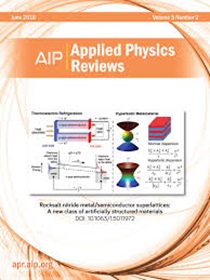电子自旋共振在新兴的自旋驱动应用:基本原理和未来展望
IF 11.9
1区 物理与天体物理
Q1 PHYSICS, APPLIED
引用次数: 0
摘要
自旋,电子的固有角动量,越来越被认为是下一代技术发展的通用工具,包括量子计算,传感和通信,利用量子现象。新兴的理论认识与技术进步相结合,促进了旨在通过调制自旋态来控制和操纵材料的光、电、磁和热性质的研究工作。在无数可用于研究这些自旋相关性质的技术中,电子自旋共振(ESR),有时被称为电子顺磁共振,作为不考虑材料环境而探测电子自旋动力学的最直接和最有效的方法之一而脱颖而出。ESR提供了关于单个自旋和团簇的状态、通过弛豫时间测量的自旋相干性以及自旋-自旋相互作用测量的自旋间距离的深刻数据。此外,ESR通过对外部磁场的调制来调整塞曼能量,更重要的是,通过在共振频率下应用微波脉冲来远程操纵自旋系统,从而促进了自旋系统的操纵。现代ESR实验装置是多功能的,可以在很宽的温度范围内使用——从几开尔文,量子效应明显,到室温甚至更高。这种适应性增强了ESR在研究凝聚态体系中自旋相关性质方面的实用性。尽管ESR提供了巨大的潜力和优势,但它仍然没有得到充分利用,特别是与非弹性中子散射(INS)和核磁共振相比,尽管后者更昂贵,INS更难获得。在这篇综述中,我们阐明了ESR的基本原理,重点是固体中的磁和自旋相互作用,并探讨了ESR在推进对各种材料科学学科中自旋性质的理解方面的潜力。我们首先简要介绍了自旋相关的物理学,然后介绍了ESR在表征自旋系统中的应用。因此,本综述旨在为广大读者提供有价值的资源,从新手到专家,他们热衷于解开材料科学和凝聚态物理中的自旋现象和动力学。本文章由计算机程序翻译,如有差异,请以英文原文为准。
Electron spin resonance in emerging spin-driven applications: Fundamentals and future perspectives
Spin, the intrinsic angular momentum of an electron, is increasingly being recognized as a versatile tool in the development of next-generation technologies, including quantum computing, sensing, and communication, which exploit quantum phenomena. The burgeoning theoretical understanding coupled with technological advancements have catalyzed research efforts aimed at controlling and manipulating the optical, electrical, magnetic, and thermal properties of materials through the modulation of spin states. Among the myriad of techniques available for investigating these spin-dependent properties, Electron Spin Resonance (ESR), sometimes referred to as electron paramagnetic resonance, stands out as one of the most direct and potent methods to probe electron spin dynamics irrespective of the material environment. ESR furnishes insightful data on the states of individual spins and clusters, spin coherence via relaxation time measurements, and inter-spin distances from spin–spin interaction measurements. Additionally, ESR facilitates the manipulation of spin systems by tailoring the Zeeman energy through the modulation of the external magnetic field, and critically, by the remote manipulation of spins via the application of microwave pulses at resonance frequencies. Modern ESR experimental setups are versatile and can be employed across a wide temperature spectrum—from a few Kelvin, where quantum effects are pronounced, to room temperature and beyond. This adaptability enhances the utility of ESR in investigating the spin-dependent properties in condensed matter systems. Notwithstanding the tremendous potential and advantages that ESR offers, it remains underutilized, especially when compared to inelastic neutron scattering (INS) and nuclear magnetic resonance, despite the latter being more expensive and INS being less accessible. In this review, we elucidate the fundamental principles of ESR, with an emphasis on magnetic and spin interactions in solids, and explore the potential of ESR in advancing the understanding of spin properties across a diverse array of materials science disciplines. We commence with a concise introduction to spin-related physics, followed by the application of ESR in characterizing spin systems. As such, this review aims to serve as a valuable resource for a broad audience, ranging from novices to experts, who are keen on unraveling spin phenomena and dynamics in materials science and condensed matter physics.
求助全文
通过发布文献求助,成功后即可免费获取论文全文。
去求助
来源期刊

Applied physics reviews
PHYSICS, APPLIED-
CiteScore
22.50
自引率
2.00%
发文量
113
审稿时长
2 months
期刊介绍:
Applied Physics Reviews (APR) is a journal featuring articles on critical topics in experimental or theoretical research in applied physics and applications of physics to other scientific and engineering branches. The publication includes two main types of articles:
Original Research: These articles report on high-quality, novel research studies that are of significant interest to the applied physics community.
Reviews: Review articles in APR can either be authoritative and comprehensive assessments of established areas of applied physics or short, timely reviews of recent advances in established fields or emerging areas of applied physics.
 求助内容:
求助内容: 应助结果提醒方式:
应助结果提醒方式:


